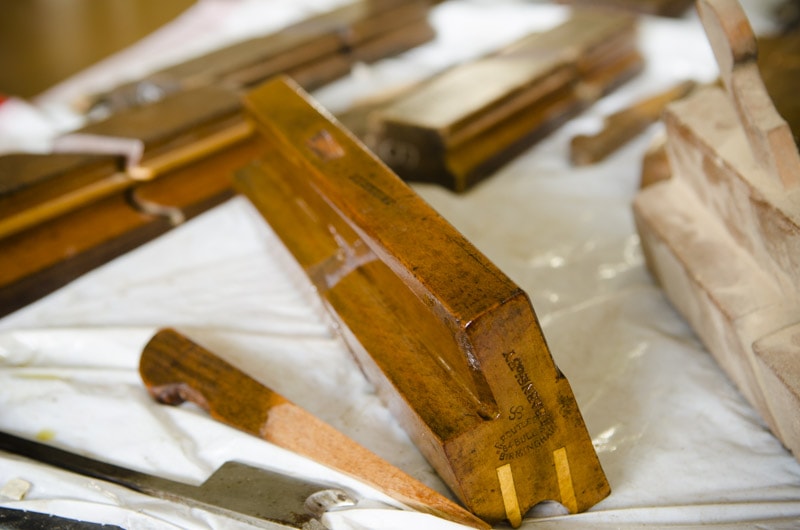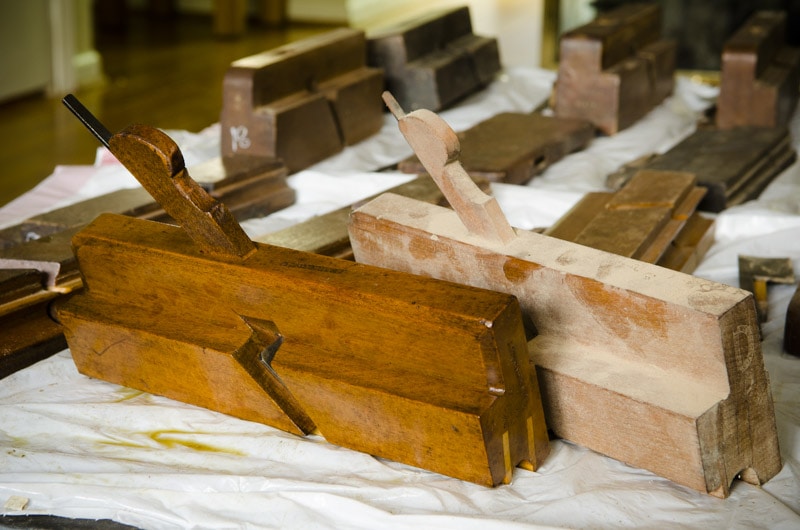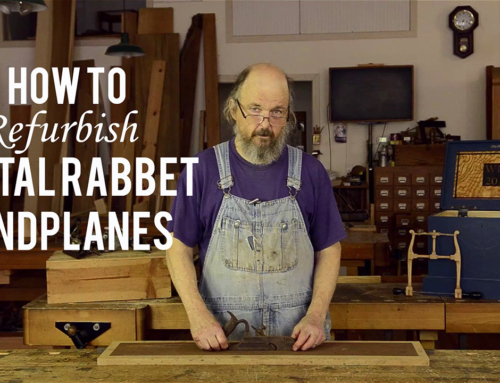In my above video I show how I clean and oil my antique molding planes. Of course, this method can apply to any wooden hand planes.  My friend was kind enough to give me about 65 antique molding planes (thanks Bill!). Instead of spending a ton of time refurbishing them all right now, I thought I’d simply clean and oil them, and refurbish a plane when needed.
My friend was kind enough to give me about 65 antique molding planes (thanks Bill!). Instead of spending a ton of time refurbishing them all right now, I thought I’d simply clean and oil them, and refurbish a plane when needed.  I like to use boiled linseed oil (if you can’t find it at a local hardware store, you can buy some here). Yes, BLO takes awhile to dry completely (1-3 days), but it’s not a big deal since these planes will sit on my shelves for a few weeks before I use one anyway. And yes, boiled linseed oil can darken over time. But I actually love the historic look of darker molding planes.
I like to use boiled linseed oil (if you can’t find it at a local hardware store, you can buy some here). Yes, BLO takes awhile to dry completely (1-3 days), but it’s not a big deal since these planes will sit on my shelves for a few weeks before I use one anyway. And yes, boiled linseed oil can darken over time. But I actually love the historic look of darker molding planes.  After oiling the molding plane body I oiled the top of the wedge, where the previous owner’s oiling job stopped. I also rubbed mineral oil on the molding plane iron (blade).
After oiling the molding plane body I oiled the top of the wedge, where the previous owner’s oiling job stopped. I also rubbed mineral oil on the molding plane iron (blade).  Now doesn’t that look beautiful? Yes. The answer is yes.
Now doesn’t that look beautiful? Yes. The answer is yes.  And now compare it with a dusty old molding plane:
And now compare it with a dusty old molding plane:  Ahhh, such satisfaction…
Ahhh, such satisfaction…  After 10-20 minutes make sure you wipe the surface with a dry cloth or paper towel to remove excess BLO and to buff the finish a tad. ***Warning: if you decide to add wax to any wooden plane, make sure you keep the wax out of the insides of the plane. Wax will prevent the wedge from sitting tight. Just think suntan lotion. Keep it on your skin and out of your mouth and any other orifice!
After 10-20 minutes make sure you wipe the surface with a dry cloth or paper towel to remove excess BLO and to buff the finish a tad. ***Warning: if you decide to add wax to any wooden plane, make sure you keep the wax out of the insides of the plane. Wax will prevent the wedge from sitting tight. Just think suntan lotion. Keep it on your skin and out of your mouth and any other orifice! 
Click here to subscribe to my future articles & videos…and please share your comments below!





That’s some friend, what a gift! It’s good to have friends like that and I envy you. I noticed in the video the way you hit the plane on the heel with your mallet to release the iron, it’s contradictory to what I’ve heard elsewhere recently (that’s the proper way for a regular plane but not molding planes). The advice I’ve seen says to strike the top of the toe against a hard surface (bench top, say) but never strike… Read more »
John, thanks for your comment. I’ve certainly been wrong in many things before, and will certainly be so again! However, this was exactly how I was taught to remove a molding plane iron at Roy Underhill’s school. Striking the heal seems to be the first (and simplest) method for removing the iron. But you are right, striking the toe against the workbench is another method. Bill Anderson taught me that he reserves the toe method for tough-to-remove irons. A third,… Read more »
Agreed, Joshua, the heel strike is the way I was taught as well and I’m still not sure how “wrong” it is. I was only recently told the heel strike is not the way to go which surprised me. Maybe my technique is wrong but the boxing on my beading plane recently started to look a bit wonky and whether this is from the impact on the heel or the heavy use I’ve given it on a couple of projects… Read more »
Hi John,
Would you mind sending me your source please? I’d be interested to see it. I figure that using a large wooden carpenter’s mallet (with a flat head) will lessen any bad impacts, and spread the trauma. At the end of the day though, these are tools and are meant to be used. The original craftsmen probably never looked at them as collectibles :)
Way back when I was collecting tools more eagerly we were told to make a mixture of linseed oil, turpentine and , I think, vinegar. This was the approved cleaning solutions for really old, greasy or blackened planes that hadn’t been looked after in 75 years. I think that’s what I remember. I still have some of the solution, 30 years old, but thickened up and rather useless. I’m looking for some support for that old theory, which I may… Read more »
Hello Graham, and welcome to a place that will rekindle your old hobby! I’m not sure about that mixture being a cleaning solution, but I use a boiled linseed oil / turpentine / beeswax mixture for furniture wax. Is that what you remember?